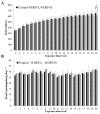Effects of Diethyl Phosphate, a Non-Specific Metabolite of Organophosphorus Pesticides, on Serum Lipid, Hormones, Inflammation, and Gut Microbiota
- PMID: 31137755
- PMCID: PMC6572208
- DOI: 10.3390/molecules24102003
Effects of Diethyl Phosphate, a Non-Specific Metabolite of Organophosphorus Pesticides, on Serum Lipid, Hormones, Inflammation, and Gut Microbiota
Abstract
Organophosphorus pesticides (OPs) can be metabolized to diethyl phosphate (DEP) in the gut environment, which may affect the immune and endocrine systems and the microbiota. Correlations between OPs and diseases have been established by epidemiological studies, mainly based on the contents of their metabolites, including DEP, in the serum or urine. However, the effects of DEP require further study. Therefore, in this study, adult male rats were exposed to 0.08 or 0.13 mg/kg DEP for 20 weeks. Serum levels of hormones, lipids, and inflammatory cytokines as well as gut microbiota were measured. DEP significantly enriched opportunistic pathogens, including Paraprevotella, Parabacteroides, Alloprevotella, and Helicobacter, leading to a decrease in interleukin-6 (IL-6). Exposure to the high dose of DEP enriched the butyrate-producing genera, Alloprevotella and Intestinimonas, leading to an increase in estradiol and a resulting decrease in total triglycerides (TGs) and low-density lipoprotein cholesterol (LDL-C); meanwhile, DEP-induced increases in peptide tyrosine‒tyrosine (PYY) and ghrelin were attributed to the enrichment of short-chain fatty acid-producing Clostridium sensu stricto 1 and Lactobacillus. These findings indicate that measuring the effects of DEP is not a proxy for measuring the effects of its parent compounds.
Keywords: DNA sequencing; endocrine system; hormones; inflammation; microbiome.
Conflict of interest statement
The authors declare no conflicts of interest.
Figures





Similar articles
-
Triazophos and its metabolite diethyl phosphate have different effects on endocrine hormones and gut health in rats.J Environ Sci Health B. 2021;56(6):566-576. doi: 10.1080/03601234.2021.1922042. Epub 2021 May 26. J Environ Sci Health B. 2021. PMID: 34038317
-
Assessment of the endocrine-disrupting effects of diethyl phosphate, a nonspecific metabolite of organophosphorus pesticides, by in vivo and in silico approaches.Environ Int. 2020 Feb;135:105383. doi: 10.1016/j.envint.2019.105383. Epub 2019 Dec 10. Environ Int. 2020. PMID: 31835022
-
Age- and diet-specific effects of chronic exposure to chlorpyrifos on hormones, inflammation and gut microbiota in rats.Pestic Biochem Physiol. 2019 Sep;159:68-79. doi: 10.1016/j.pestbp.2019.05.018. Epub 2019 May 27. Pestic Biochem Physiol. 2019. PMID: 31400786
-
Gut microbiota: An underestimated and unintended recipient for pesticide-induced toxicity.Chemosphere. 2019 Jul;227:425-434. doi: 10.1016/j.chemosphere.2019.04.088. Epub 2019 Apr 13. Chemosphere. 2019. PMID: 31003127 Review.
-
Connecting the immune system, systemic chronic inflammation and the gut microbiome: The role of sex.J Autoimmun. 2018 Aug;92:12-34. doi: 10.1016/j.jaut.2018.05.008. Epub 2018 Jun 1. J Autoimmun. 2018. PMID: 29861127 Review.
Cited by
-
Association between organophosphorus insecticides exposure and osteoarthritis in patients with arteriosclerotic cardiovascular disease.BMC Public Health. 2024 Jul 14;24(1):1873. doi: 10.1186/s12889-024-19414-9. BMC Public Health. 2024. PMID: 39004719 Free PMC article.
-
Traditional Chinese Medicine Formula Kang Shuai Lao Pian Improves Obesity, Gut Dysbiosis, and Fecal Metabolic Disorders in High-Fat Diet-Fed Mice.Front Pharmacol. 2020 Mar 25;11:297. doi: 10.3389/fphar.2020.00297. eCollection 2020. Front Pharmacol. 2020. PMID: 32269525 Free PMC article.
-
Maternal resveratrol improves the intestinal health and weight gain of suckling piglets during high summer temperatures: The involvement of exosome-derived microRNAs and immunoglobin in colostrum.Anim Nutr. 2024 Jan 29;17:36-48. doi: 10.1016/j.aninu.2024.01.002. eCollection 2024 Jun. Anim Nutr. 2024. PMID: 38464951 Free PMC article.
-
Polysaccharides from Pseudostellaria heterophylla modulate gut microbiota and alleviate syndrome of spleen deficiency in rats.Sci Rep. 2022 Nov 23;12(1):20217. doi: 10.1038/s41598-022-24329-9. Sci Rep. 2022. PMID: 36418343 Free PMC article.
-
Maternal resveratrol regulates the growth performance, antioxidant capacity, and intestinal health of suckling piglets through intestinal microorganisms at high summer temperatures.Front Nutr. 2022 Sep 9;9:971496. doi: 10.3389/fnut.2022.971496. eCollection 2022. Front Nutr. 2022. PMID: 36159472 Free PMC article.
References
-
- USDA (United States Department of Agriculture) Pesticide Data Program: Annual summary, calendar year 2011. [(accessed on 3 October 2018)]; Available online: http://www.ams.usda.gov/AMSv1.0/getfile?dDocName=stelprdc5102692.
-
- PRiF (Expert Committee on Pesticide Residues in Food) Pesticide residues monitoring programme for quarter 1 2013. [(accessed on 3 December 2013)]; Available online: http://www.pesticides.gov.uk/Resources/CRD/PRiF/Documents/Results%20and%...
-
- FSANZ (Food Standards Australia New Zealand) The 23rd Australian Total Diet Survey. [(accessed on 18 December 2013)]; Available online: http://www.foodstandards.gov.au/publications/pages/23rdaustraliantotald5....
MeSH terms
Substances
Grants and funding
LinkOut - more resources
Full Text Sources
Medical

